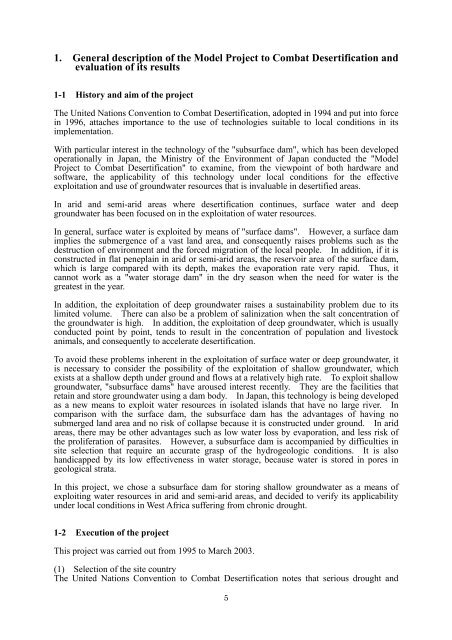SubSurface Dams - Sustainable Sanitation and Water Management ...
SubSurface Dams - Sustainable Sanitation and Water Management ...
SubSurface Dams - Sustainable Sanitation and Water Management ...
You also want an ePaper? Increase the reach of your titles
YUMPU automatically turns print PDFs into web optimized ePapers that Google loves.
1. General description of the Model Project to Combat Desertification <strong>and</strong>evaluation of its results1-1 History <strong>and</strong> aim of the projectThe United Nations Convention to Combat Desertification, adopted in 1994 <strong>and</strong> put into forcein 1996, attaches importance to the use of technologies suitable to local conditions in itsimplementation.With particular interest in the technology of the "subsurface dam", which has been developedoperationally in Japan, the Ministry of the Environment of Japan conducted the "ModelProject to Combat Desertification" to examine, from the viewpoint of both hardware <strong>and</strong>software, the applicability of this technology under local conditions for the effectiveexploitation <strong>and</strong> use of groundwater resources that is invaluable in desertified areas.In arid <strong>and</strong> semi-arid areas where desertification continues, surface water <strong>and</strong> deepgroundwater has been focused on in the exploitation of water resources.In general, surface water is exploited by means of "surface dams". However, a surface damimplies the submergence of a vast l<strong>and</strong> area, <strong>and</strong> consequently raises problems such as thedestruction of environment <strong>and</strong> the forced migration of the local people. In addition, if it isconstructed in flat peneplain in arid or semi-arid areas, the reservoir area of the surface dam,which is large compared with its depth, makes the evaporation rate very rapid. Thus, itcannot work as a "water storage dam" in the dry season when the need for water is thegreatest in the year.In addition, the exploitation of deep groundwater raises a sustainability problem due to itslimited volume. There can also be a problem of salinization when the salt concentration ofthe groundwater is high. In addition, the exploitation of deep groundwater, which is usuallyconducted point by point, tends to result in the concentration of population <strong>and</strong> livestockanimals, <strong>and</strong> consequently to accelerate desertification.To avoid these problems inherent in the exploitation of surface water or deep groundwater, itis necessary to consider the possibility of the exploitation of shallow groundwater, whichexists at a shallow depth under ground <strong>and</strong> flows at a relatively high rate. To exploit shallowgroundwater, "subsurface dams" have aroused interest recently. They are the facilities thatretain <strong>and</strong> store groundwater using a dam body. In Japan, this technology is being developedas a new means to exploit water resources in isolated isl<strong>and</strong>s that have no large river. Incomparison with the surface dam, the subsurface dam has the advantages of having nosubmerged l<strong>and</strong> area <strong>and</strong> no risk of collapse because it is constructed under ground. In aridareas, there may be other advantages such as low water loss by evaporation, <strong>and</strong> less risk ofthe proliferation of parasites. However, a subsurface dam is accompanied by difficulties insite selection that require an accurate grasp of the hydrogeologic conditions. It is alsoh<strong>and</strong>icapped by its low effectiveness in water storage, because water is stored in pores ingeological strata.In this project, we chose a subsurface dam for storing shallow groundwater as a means ofexploiting water resources in arid <strong>and</strong> semi-arid areas, <strong>and</strong> decided to verify its applicabilityunder local conditions in West Africa suffering from chronic drought.1-2 Execution of the projectThis project was carried out from 1995 to March 2003.(1) Selection of the site countryThe United Nations Convention to Combat Desertification notes that serious drought <strong>and</strong>5
















